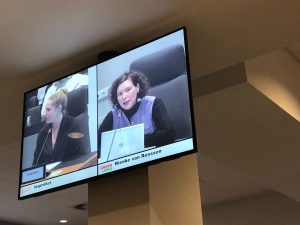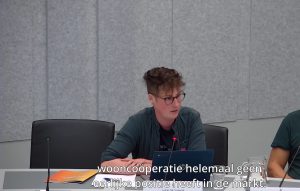Thijs Witty – De Nieuwe Meent is about finding the right balance between all members. It is also about figuring out how everyone can move at their own pace. That’s a real challenge, but also what makes the project so uniquely exciting.
I joined de Nieuwe Meent in the spring of last year, after finally managing to free up enough time. Friends had been working incessantly on the project ever since the gemeente announced the tender competition for the Archimedesplantsoen in 2018, but as usual I was kind of late to the party. From the get-go I was drawn to the ambitions of dNM, which felt very close to what I believe collective living should be about. But I also felt a bit forced to join, because dNM offered the only meaningful way to find an affordable house in Amsterdam, a place I had chosen to love and live in since 2005, but that had also made me move around no less than ten times, under increasingly unaffordable and precarious conditions. I’ll leave the city’s clusterfuck housing situation for another blog post, but suffice it to say that my reason to join dNM was motivated equally by altruism and desperation.
I quite like this ambivalence, however, which incidentally brings me to the subject of this post: French writer Roland Barthes. His Wikipedia page is pretty good for first impressions, and if you want a solid pick for a first read I’d recommend A Lover’s Discourse – it’s breathtaking. For the sake of this blog, all you need to know is that Barthes made a career out of exploring every possible ambivalence of the human experience. And for the sake of coherence, you should know that I was working on the man’s writings and life for my graduation thesis, which was the main reason why I was initially too busy to commit to dNM. But as it turned out, all was not lost!

Ambivalences, ambivalences, and ambivalences
I love all of Barthes’ books, although my personal favourite can only be called a book in the most desperate sense of the word. It’s titled Mourning Diary and was published posthumously in 2012, over 30 years after Barthes’ own untimely death in 1980. It’s a collection of short fragments – some pages don’t contain more than a couple of half-finished sentences – that he started scribbling down in October 1977, a few days after his own mother had passed away. He kept the diary for two years, which was equivalent to the official grieving period according to an etiquette guide he had found on one of his bookshelves. Besides following that two-year bracket, Barthes refused to account for his feelings with any other rule or formula. What I find so striking about the book is that it describes a suffering that is profoundly non-developmental, something very distant from what we usually hear about the stages of grief. “What I find utterly terrifying is mourning’s discontinuous character”, Barthes observes at some point, to which he adds a little further on: “don’t say Mourning. It’s too psychoanalytic. I’m not mourning. I’m suffering.”
What does his book have to do with de Nieuwe Meent? Quite a lot, both in a personal and more general, visionary way, although that vision is probably quite obscure and in need of unpacking.
As for the personal resonance: I see a lot of my own ambivalences about living with an intentional community mirrored in the struggles Barthes describes at length in the diary. He lived with his mother for most of his adult life, including at the time of her passing, and this intergenerational co-habitation was the subject of a lot of his most insightful writings. One of the more beautiful ambitions of de Nieuwe Meent is to create a cross-generational living experience, where people in different stages of their life can enjoy each other’s company, give and receive help, and learn from both youthful adventure and matured wisdom. It’s a dynamic exchange that Barthes appreciated as well, but at times it was at the expense of his own flourishing. What happens when a child must become the parent, and vice versa?
The visionary part will need some more detours. At the time that Barthes was writing his mourning diary, he was also preparing a lecture course for the fall term at the Collège de France, a prestigious academic institution in Paris. The subject of the seminar was the concept of neutrality, a term he used to describe all kinds of ways in which conflictual language could be avoided or suspended. It was also the concept Barthes used to reconcile his own innumerable ambivalences in daily life: by neutralising the pros and cons of any experience or situation, Barthes’ ultimate desire was to live in a suspended state, where he could be nudged from decision to decision not by sheer conviction or blind faith, but by the playful dance of neutrality. When I first read the lecture notes of his Collège seminar, it felt like I had found my bible. It was and remains among the main reasons I could keep my energies up with all the organising and planning thus far. There is also much more than a passing resemblance between Barthes’ ideas surrounding neutrality and the decision-making model we chose as an association: consensus – but again, more about that in a future post.
Back to the lecture course. It is tempting to think that Barthes’s turn towards neutrality was triggered by his mother’s death and that he was looking for a way to alleviate his grief, but his attraction to the concept is evident throughout his intellectual trajectory, starting with his famous notion of the “degree zero of writing” from the early 1950s. But now that Barthes would spend an entire semester pursuing glimpses of his longer-standing fantasy, all the while recording the pains of his own suffering body, neutrality would finally receive the full attention he had only hinted at before. Among the most compelling earlier reflections is a particularly beautiful passage from Roland Barthes by Roland Barthes, a strange hybrid between autofiction and biography. Here Barthes gestures towards the fundamental importance of neutrality in his life and work by describing a game he used to play as a child on the streets of Paris:
When I used to play prisoner’s base in the Luxembourg, what I liked best was not provoking the other team and boldly exposing myself to their right to take me prisoner; what I liked best was to free the prisoners—the effect of which was to put both teams back into circulation: the game started over again at zero. In the great game of the powers of speech, we also play prisoner’s base: one language temporary rights over another; all it takes is for a third language to appear from the ranks for the assailant to be forced to retreat: in the conflict of rhetorics, the victory never goes to any but the third language. The task of this language is to release the prisoners.
Neutrality after Barthes would point to individual and collective attempts to liberate things from strongholds. It almost sounds like a dNM rally-cry. But that’s not quite where I want the detour to end.
Unique rhythms
The year before his lectures on neutrality and his mourning diary, Barthes had given a course about alternative ways of living. In many ways this lecture series, titled How to live together, is the crown achievement of this intellectual trajectory. It is at once highly experimental and erudite, ambitious and modest, expansive and contracted; oppositional mixtures between collective knowledges and personal wisdoms that had taken Barthes over four decades to perfect. But in this precise sense I also see Barthes’ lecture course as a revisitation of many unresolved tensions in his previous works, specifically with regards to language, the social life of symbols, and his own paradoxical desire for both solitude and community.

In the course, Barthes explores the concept of “idiorrhythmy,” a form of communal living in which all members recognise and respect the individual rhythms of the others. Barthes’ lecture series explores the history of many different communities of individuals who chose to live their lives completely removed from the public sphere. It is a study of so-called heremitism, including figures such as dendrites, grazers, and stationaries, who are all types of people who choose to live in margins of society, or at least in some state of self-chosen marginality. In Barthes’ understanding, that marginality doesn’t have the regular ideological connotations of resistance or critique: it was in fact a positive fantasy that he hoped to pursue himself. “It is in dreaming that the hermit finds happiness and calm, away from the demands of the public sphere”, he argued, suggesting that living ‘in’ society obstructs real dreaming, which would be a much worse problem for him than non-participation or withdrawal. As he observes, “The better the hermit knows the community and the harder he strives to belong to it, the more he will want to distance from it, to turn its back.” In other words, solitude does not come before the community, the community is responsible for the solitude of the hermite. That seemed to be Barthes’s main point in the lectures: society can’t stand people who refuse to participate in its politics.
When you think of it that way, grazers, dendrites, stationeries, drifters, and hermits are actually more threatening than revolters, because a revolt will eventually always pass and then be channelled again into some kind of continuity. Hermites, or people who prefer to distance themselves from the societal centre, had no political plans except for withdrawal. A glaring issue, however, is that the uniquely selfish ways of the hermite seem incompatible with the notion of living together. And isn’t sheer individualism precisely what must be resisted when you think seriously about community?
Barthes tried to circumvent this question altogether by pointing out its false premises. The question we should ask instead is: how to live in a community where one’s own unique rhythm would not be disturbed? The important rule here is that Barthes sees no contradiction at all about wanting to live in a solitary way and wanting to live together. The challenge is not to ‘solve’ this tension (which would suggest that it is a conflict that somehow needs to be fixed in either one of two ways), but rather to find a play that moves the dynamic between them in a meaningful play. A little bit like the prisoner’s game.
Society always imposes a general rhythm on people, for example by framing them as consumers, workers or participants. For Barthes, the only real answer to this imposition is idiorrhythmy. Here we encounter the first instance of a ‘real’ suggestion in the lectures, where idiorrhythmy moves beyond the level of an appealing fantasy. The term is also concretely about “solitude with regular interruptions” and what must emerge from the concept is a “socialism of distances”: idiorrhythmy is about a flowing dynamic that allows for improvisation in the concrete experience of living together and opposes fixed agendas and schemes. Does that ring a bell? I find here again Barthes’ lifelong obsessions with neutralising play, actions that force movements to oscillate indefinitely.
Idiorrhythmy names a singular mode of being that is nonetheless always in negotiation with other singular modes. It implies an ongoing care for one’s own habits insofar as they can be reflected in another’s habits. Through idiorrhythmy, ambivalences surrounding intentional communal living become less agonising and more like improvisational challenges. In fact, How to live together almost offers a moral imperative: neutering the conflict-prone dances in any living community, without imposing a single structure, points towards a utopian vision of small-scale society. The only real caution it keeps raising is an open question: how to insist on your own unique pace without arrogance or compromising with the group to which you nonetheless always belong?
There is so much more stuff in the lectures, so I could go on indefinitely. It really is a rewarding text to read and revisit. I also think that for all the experimentation and innovations that de Nieuwe Meent embodies, it’s nice to be reminded of the many established yet forgotten or ignored forms of life that preceded our own effort.
Invitations to roam
On a final note, there is one more affinity between Barthes’ mourning of his mother and my attraction to de Nieuwe Meent. When Barthes was appointed as lecturer at the Collège de France, he was asked to speak about his philosophy of education. In this inaugural lecture Barthes announced his wish to teach from a place of modesty and child-like curiosity. He thought that such a course could only ever be taught by a professor who was more banal than his audience, and that he could only speak from a space of playful intimacy with the topics he would ‘scatter’ around. In psychoanalysis this space was often aligned with the body of the mother, available to the child before language divides it from the objects animating its desire. The moment when an all-knowing teacher or expert withdraws from the scene of learning, the remaining listeners are invited to roam: “I should therefore like the speaking and the listening that will be interwoven here to resemble the comings and goings of a child playing beside his mother, leaving her, returning to bring her a pebble, a piece of string, and thereby tracing around a calm center a whole locus of play within which the pebble, the strings come to matter less than the enthusiastic giving of them.”
In a way, we are at home only when we have that familiarity, which allows us to grab our phone from the night stand in the pitch dark or find the light switch above our pillow without fail: an intimate, sightless familiarity, and a trust that your place is patterned to how you want it. It’s everything I hope de Nieuwe Meent will become, uniquely for every individual member.




